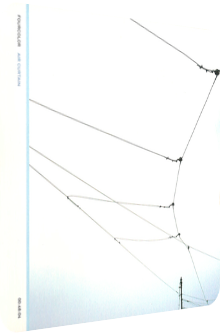
Fourcolor
Air Curtain
2004
I'm a fan of Glitch Ambient. I love the approach of Japanese artists in this regard, especially so on Air Curtain by Minamo and Fonica member Keiichi Sugimoto. Released in 2004 on the 12k label, Air Curtain manages to merge the iridescent fragility of Tetsu Inoue's sustained textures with the bleepy pops and coruscating crackles of Oval and Michael Santos. If you favor the styles of all these artists, you surely know about Sugimoto's music already. While Glitch Ambient can be very relaxing and melodious, the melodies themselves aren't particularly catchy most of the time. You cannot hum along with them. It is more about the texture of each sound, the implicit aesthetics encapsulated in the audible waves and the euphony of the concourse between all layers rather than a catchy riff. The result is usually icy, but by no means clinically sterile. This kind of music is able to sound organic due to thermal zephyrs that waft through the vast wideness or intimate closeness of each song. I've chosen Air Curtain, Sugimoto's second solo album, because it is a glitch-perfect example of an oxymoronic Ambient style full of glacial warmth, airy heaviness and high-pitched deepness. The seven tracks are occasionally too focused on the Glitch and tone burst side, but otherwise tend to the melodious spectrum. I have to admit upfront that Air Curtain doesn't enhance or break the Glitch Ambient formula in a meaningful way, but that is totally fine with me since it is flawlessly presented.
Curves Of Air begins with the typical coupling of frosty synth pulses with hibernal clicks, followed by a warm drone that underlines the simultaneous occurrence of coldness and warmth. A scintillating, monotonous string is added, encapsulating the quiescence and fragility reminiscent of Tetsu Inoue's Inland. The attractiveness of this song lies in the terrific interplay of this string with the deep drone, again resulting in an oxymoronic buildup of dark brightness that is so typical of this genre. Towards the end, Curves With Air gets brighter due to additional galactic sparkles. A terrific opener. Empty Sky 1 is next, and juxtaposes shimmering strings with liquid bass lines. Electronic birds and crickets click their way through the crystalline setting which is later augmented by glinting glockenspiels and piercing droplets of ice. AE marks a counterpoint in regard to the formula by introducing a tweaked steel guitar to tremendously warm pulses, resulting in an Oval-esque interplay between space and sound with only the slightest remnants of a reverberation. A variety of static noise bursts and crackles boost the calmness of the scenery, while a phantasmagoric synth drone flows in the background, shifting slightly. A very good track as long as you can bear the interchanging space-sound approach in the first half of the AE.
2 Strings lets you in on the secret via its title already and consists of the mélange of glinting pulses and an overdriven guitar string that plays quietly in the background. I am not particularly fond of this track, but have to admit that its second half is way better when the guitar string vanishes and makes room for the soothing plasticity of a resplendent stream of oscillating warmth. Cloud Whereabouts starts with a vestigial loop of crunchy pulses, while additional warm pulses and the surprising addition of slowly meandering but punchy beats enhance the deepness of the minimal setting. The second half enhances the clicky iciness and high-pitched loftiness with gently screeching beeps. As Rain, however, takes the cake of the album, as this gigantic track is built upon a gorgeously deep three second loop that is hazy and muffled, yet pristine and rapturous. Sugimoto takes his time to let the listener soak in the airy deepness which is only slightly broadened by short clangs, zipping noises, bursting clicks and bass pulses. After five and a half minutes, the gorgeous loop wanes and is substituted by terrific synth pulses that remind me of Japanese video games of all kinds when you choose options in their menu screens. A superb track and the very best of Air Curtain. Not to be missed! The final piece is Empty Sky 2 re-uses the glitchy melodies of its predecessor, but puts them into the limelight. The melody is thus punchier than before, while multilayered synth strings and gentle noises whirl in the deeper regions of the track. Deep bass drones and friendly guitar strings float into the mix with fake birds chirping in the background, possibly remnants of bit crushing filters. The album hence ends on a content note, proving to be a very good Glitch entry that luckily focuses more on the melodious side than on the cacophonous parts.
Air Curtain is a very good Glitch album that will definitely please fans of the genre. Although it doesn't offer any particular surprise to this subgenre that became strong in the middle of the 90's, Keiichi Sugimoto's second solo offering is wonderfully fragile and offers the right doses of contrastive ingredients. The true achievement lies in the simultaneity of the multiple layers, making it hard to pinpoint a certain mood: a glacial string usually inherits a warm drone layer in Fourcolor's music, and abrupt tone bursts are so vivid and attractive that they remain stuck in your head even minutes later when a certain track morphed into something different. Most tracks can be sliced into two phases, with certain elements fading out in order to make room to similar and compatible ones. The album never succumbs to the incredible warm fields of jitter as found in Oval's 94 Diskont, but it is nonetheless melodious enough to not cross the line into the IDM side of Glitch, if you allow me such an allegation. As Rain is the catchy signature track on this album, and the gap of further truly outstanding offerings is actually a positive aspect of the coherence and harmony depicted by Air Curtain, as every track displays the same care and overarching concept of intermingling counterparts. Glitch Ambient fans can get this album without hesitation, everyone else might pre-listen to the aforementioned As Rain and Curves Of Air.
Ambient Review 064: Fourcolor – Air Curtain (2004). Originally published on Apr. 25, 2012 at AmbientExotica.com.
